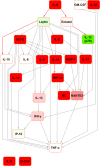A Bayesian view of murine seminal cytokine networks
- PMID: 29190674
- PMCID: PMC5708769
- DOI: 10.1371/journal.pone.0188897
A Bayesian view of murine seminal cytokine networks
Abstract
It has long been established that active agents in seminal fluid are key to initiating and coordinating mating-induced immunomodulation. This is in part governed by the actions of a network of cytokine interactions which, to date, remain largely undefined, and whose interspecific evolutionary conservation is unknown. This study applied Bayesian methods to illustrate the interrelationships between seminal profiles of interleukin (IL)-1alpha, IL-1beta, IL-2, IL-4, IL-5, IL-6, IL-9, IL-10, IL-12 (p70), IL-13, IL-17, eotaxin, granulocyte-colony stimulating factor (G-CSF), granulocyte macrophage-colony stimulating factor (GM-CSF), interferon (IFN)-gamma, keratinocyte-derived chemokine (KC), monocyte chemoattractant protein (MCP-1), macrophage inflammatory protein (MIP-1) alpha, MIP-1beta, regulated on activation normal T cell expressed and secreted (RANTES), tumour necrosis factor (TNF)-alpha, leptin, inducible protein (IP)-10 and vascular endothelial growth factor (VEGF) in a rat model. IL-2, IL-9, IL-12 (p70), IL-13, IL-18, eotaxin, IFN-gamma, IP-10, KC, leptin, MCP-1, MIP-1alpha and TNF-alpha were significantly higher in serum, whilst IL-1beta, IL-5, IL-6, IL-10, IL-17, G-CSF and GM-CSF were significantly higher in seminal fluid. When compared to mouse profiles, only G-CSF was present at significantly higher levels in the seminal fluid in both species. Bayesian modelling highlighted key shared features across mouse and rat networks, namely TNF-alpha as the terminal node in both serum and seminal plasma, and MCP-1 as a central coordinator of seminal cytokine networks through the intermediary of KC and RANTES. These findings reveal a marked interspecific conservation of seminal cytokine networks.
Conflict of interest statement
Figures








References
-
- Cardoso E, Arregger A, Coumroglon M, Andrada EC, Andrada JA. Seminal plasma modulates lymphokine-activated killer cell activity in vitro. Minerva Endocrinol. 1993;18(3): 109–14. - PubMed
-
- Koch E, Ellendorff F. Detection of activity similar to that of early pregnancy factor after mating sows with a vasectomized boar. J Reprod Fertil. 1985;74(1): 39–46. - PubMed
-
- Liang ZG, Kamada M, Koide SS. Binding of a specific subclass of immunoglobulins by a human seminal plasma component. Andrologia. 1993;25(5): 279–82. - PubMed
-
- Saxena S, Jha P, Farooq A. Purification and characterisation of an immunosuppressive factor from normal human seminal plasma. J Reprod Immunol. 1988;13(2): 133–46. - PubMed
MeSH terms
Substances
LinkOut - more resources
Full Text Sources
Other Literature Sources
Miscellaneous

